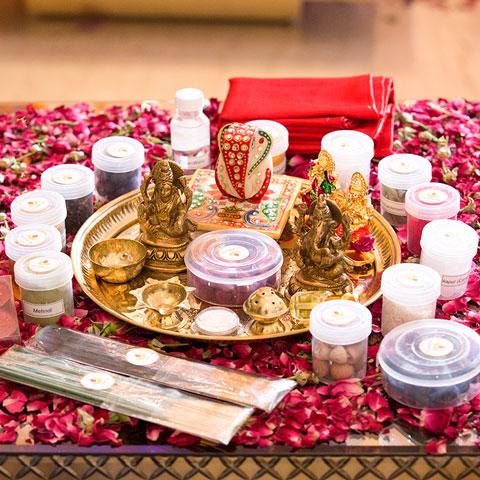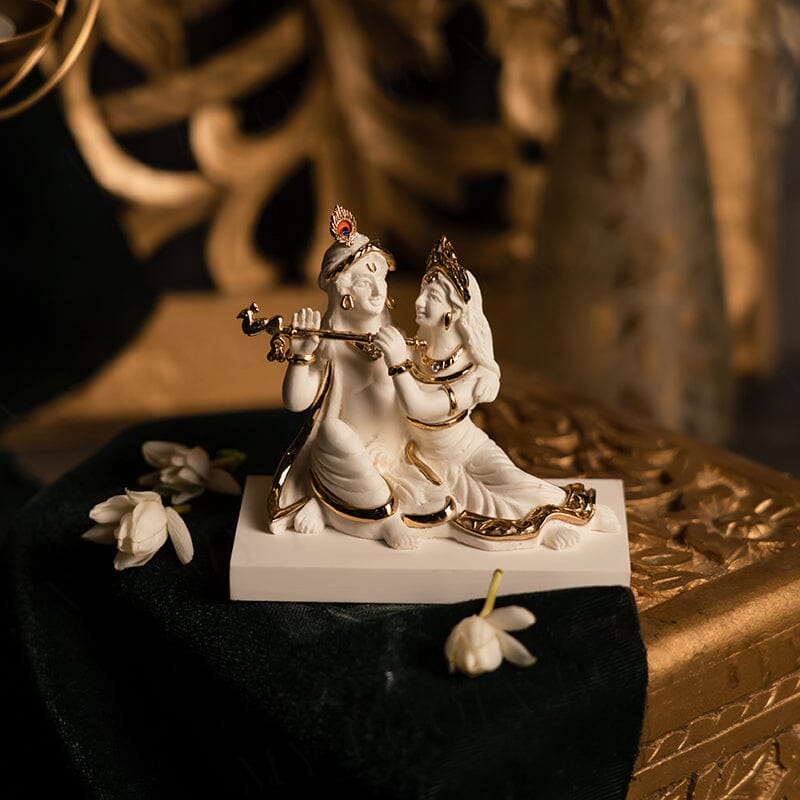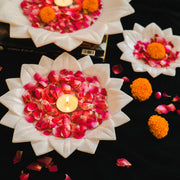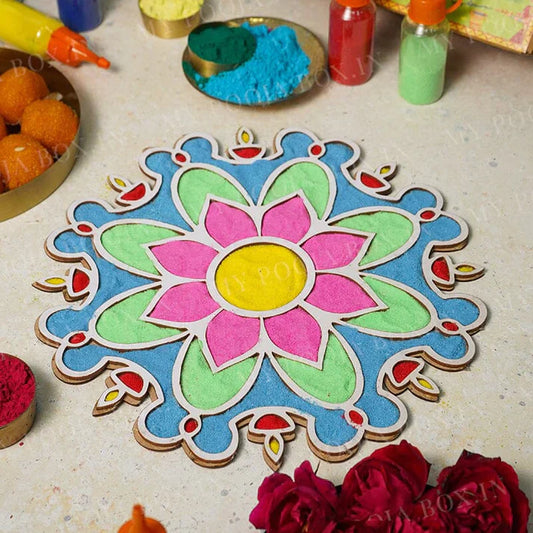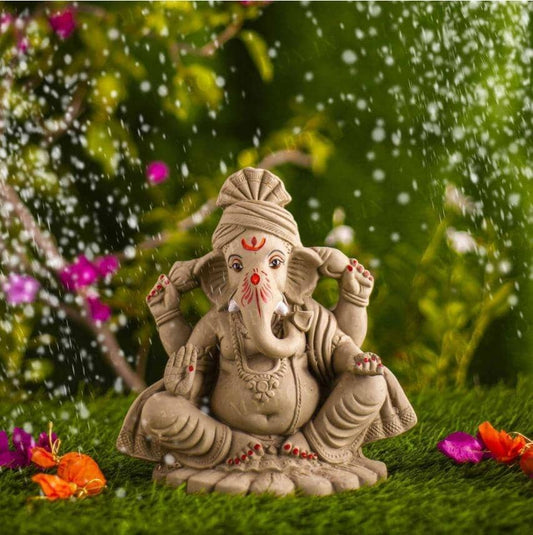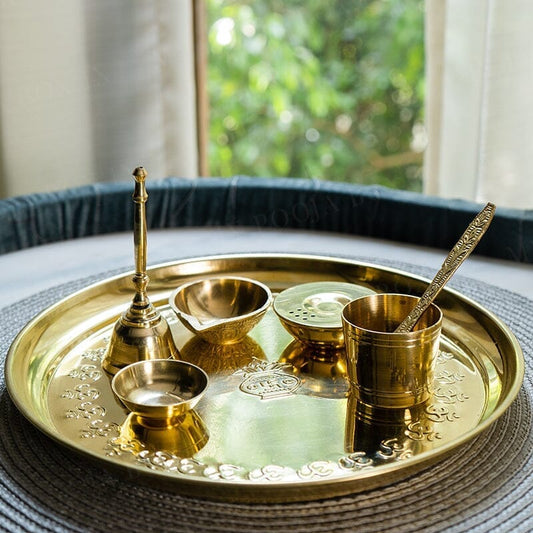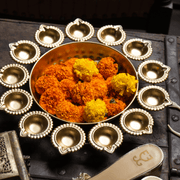Diwali, also known as Deepavali, is the festival of lights, celebrated by millions around the world. It marks the victory of Lord Rama over Ravana and symbolizes the triumph of light over darkness. It is a time to seek blessings for prosperity, health, and happiness by honoring Goddess Lakshmi (the goddess of wealth) and Lord Ganesha (the remover of obstacles).
In this guide, we will walk you through the history, significance, timing, rituals, and mantras to help you perform the Diwali Puja at home, ensuring that your celebration is both meaningful and spiritually fulfilling.

History and Significance of Diwali
Why is Diwali celebrated?
Diwali is celebrated to honor Lord Rama's return to Ayodhya after defeating the demon king Ravana. It marks the victory of good over evil and light over darkness. Additionally, Goddess Lakshmi, the goddess of wealth and prosperity, is worshipped on this day to invite her divine blessings into the home.
What is the spiritual significance of Diwali?
Diwali also represents a time of spiritual renewal, purification, and seeking new beginnings. The lighting of diyas (oil lamps) symbolizes the illumination of our inner selves and the removal of darkness and ignorance.
Diwali Date, Time, and Shubh Muhurat
When is Diwali in 2025?
In 2025, Diwali will be celebrated on Monday, 20th October 2025. The celebration will begin with Lakshmi Puja on this day, marking the beginning of the 5-day festival.
What is the best time for Diwali Puja?
The most auspicious time for performing Diwali Puja in 2025 is during the Shubh Muhurat. Below are the timings for Lakshmi Puja:
-
Date for Diwali Puja: Monday, 20th October 2025
-
Laxmi Puja Muhurat (Duration- 01 Hour 11 Mins):
-
Starts: 20th October at 07:07 pm
-
Ends: 20th October at 08:17 pm
-
Pradosh Kaal:
-
20th October from 05:45 pm - 08:17 pm
-
Vrishabha Kaal:
- 20th October from 07:07 pm - 09:02 pm
-
Brahma Yoga:
-
20th October from 04:30 am - 05:16 am
-
Rahukaal (inauspicious time):
-
20th October from 07:36 am to 09:10 am
(Avoid performing puja during this period) -
Midday Diwali Puja Timings (Abhijit Muhurta):
-
20th October from 11:53 am - 12:43 pm

-
20th October from 11:53 am - 12:43 pm
Step-by-Step Diwali Puja Vidhi
How to Perform Diwali Puja at Home?
Step 1: Clean Your Home and Set Up the Altar
-
Start by cleaning your home thoroughly to welcome Goddess Lakshmi.
-
Decorate your puja altar with diyas (oil lamps), rangolis, flowers, and fairy lights to invite positivity.
-
Place the idols of Lord Ganesha and Goddess Lakshmi on the altar, ensuring they are placed on an elevated surface or pedestal.
Step 2: Invocation (Avahana) and Installation (Pratishthapana) of the Idols
Mantra for Avahana (Invocation):
-
"He Heramba Tvamehyehi Hyambikatryambakatmaja, Siddhi-Buddhi Pate Tryaksha Lakshalabha Pituh Pitah."
-
"Nagasyam Nagaharam Tvam Ganarajam Chaturbhujam, Bhushitam Svayudhaudavyaih Pashankushaparashvadhaih."
-
"Avahayami Pujartham Rakshartham Cha Mam Kritoh, Ihagatya Grihana Tvam Pujam Yagam Cha Raksha Me."
-
"Om Siddhi-Buddhi Sahitaya Shri Mahaganadhipataye Namah."
-
"Avahayami-Sthapayami."
This mantra is used to invoke Lord Ganesha and Goddess Lakshmi into the idols, welcoming their divine presence.
Mantra for Pratishthapana (Installation):
-
"Asyai Pranah Pratishthantu Asyai Pranaksharantu Cha."
-
"Asyai Devatvamarchayai Mamaheti Cha Kashchana."
-
"Om Siddhi-Buddhi Sahitaya Shri Mahaganadhipataye Namah."
-
"Supratishtho Varado Bhava."
This mantra helps in installing life into the idols, completing the installation process.
Step 3: Offering a Seat to the Divine (Asana Samarpan)
Mantra for Asana Samarpan (Offering a seat):
-
"Vichitraratnakhachitam Divyastaranasamyutam."
-
"Swarna Simhasanam Charu Grihana Guhagraja."
-
"Om Siddhi-Buddhi Sahitaya Shri Mahaganadhipataye Namah."
-
"Asanam Samarpayami."
Take five flowers in your palms, recite the mantra, and offer the seat to Lord Ganesha and Goddess Lakshmi.
Step 4: Offering Water (Achamana) to the Idols
Mantra for Achamana (Offering water):
-
"Vighnaraja Namastubhyam Tridashairabhivandita."
-
"Gangodakena Devesha Kurushwachamanam Prabho."
-
"Om Siddhi-Buddhi Sahitaya Shri Mahaganadhipataye Namah."
-
"Mukhe Achamaniyam Samarpayami."
Step 5: Bathing the Idols (Snana)
Panchamrita Snanam (Bathing with Panchamrit):
-
"Panchamritam Mayaaanitam Payodadhi, Ghritam Madhu."
-
"Sharkara Cha Samayuktam Snanartham Pratigrihyatam."
Offer the Panchamrit to the idols of Lord Ganesha and Goddess Lakshmi.
Payah Snanam (Milk Bath):
-
"Kamadhenusamudbhutam Sarvesham Jivanam Param."
-
"Tejah Pushtikaram Divyam Snanartham Pratigrihyatam."
Offer milk while chanting the above mantra.
Dadhi Snanam (Curd Bath):
-
"Payasastu Samudbhutam Madhuramlam Shashiprabham."
-
"Dadhyanitam Mayadeva Snanartham Pratigrihyatam."
Step 6: Offering Clothes to the Idols (Vastra Samarpan)
Mantra for Vastra Samarpan (Offering clothes):
-
"Shitavatoshna Santranam Lajjaya Rakshanam Parama."
-
"Dehalankaranam Vastramatah Shanti Prayachchha Me."
-
"Om Siddhi-Buddhi Sahitaya Shri Mahaganadhipataye Namah."
-
"Vastram Samarpayami."
Offer new clothes to the idols, symbolizing prosperity and abundance.
Step 7: Offering Flowers (Pushpa Mala)
Mantra for Pushpa Mala (Offering flowers):
-
"Malyadini Sugandhini Malyadinivai Prabhuh."
-
"Maya Hritani Pushpani Grihyantam Pujanaya Bhoh."
-
"Om Siddhi-Buddhi Sahitaya Shri Mahaganadhipataye Namah."
-
"Pushpamalam Samarpayami."
Step 8: Lighting Diyas (Deep Samarpan)
Mantra for Deep Samarpan (Offering oil lamps):
-
"Om Deep Jyoti Parabrahma, Deepo Me Hara Sada."
Light the diyas and offer them to Goddess Lakshmi and Lord Ganesha as a symbol of inviting prosperity and knowledge.
Step 9: Offering Sweets (Naivedya)
Mantra for Naivedya Samarpan (Offering sweets):
-
"Om Lakshmiyai Namah, Om Ganeshaya Namah."
Offer sweets like laddoos and modaks, as well as fruits, to complete the puja and seek blessings.
Step 10: Performing Aarti (Aarti Samarpan)
Perform the Aarti of Lord Ganesha and Goddess Lakshmi, reciting the following:
Ganesh Aarti:
-
"Sukhkarta Dukhharta Varta Vighnachi."
Lakshmi Aarti:
-
"Om Jai Lakshmi Mata, Maiya Jai Lakshmi Mata."

Step-by-Step Ganesh and Lakshmi Visarjan (Immersion)
After the puja, conclude the celebration with Visarjan (immersion of the idols in water), symbolizing the deities' return to their divine home. Chant:
"Ganpati Bappa Morya, Pudhchya Varshi Lavkar Ya."
Frequently Asked Questions (FAQs)
When should I perform Diwali Puja?
The best time to perform Lakshmi Puja during Diwali 2025 is during 07:07 pm - 08:17 pm on 20th October.
What is the significance of performing Diwali Puja?
Diwali Puja is important for inviting Goddess Lakshmi into your home, seeking her blessings for wealth and prosperity. It also honors Lord Ganesha, the remover of obstacles, for success and happiness in the coming year.
How long should I keep the diyas lit?
It’s customary to keep the diyas burning throughout the night of Diwali to symbolize the triumph of light over darkness.
Celebrate Diwali with Light, Love, and Prosperity
Performing Diwali Puja at home is not only a way to seek divine blessings but also a chance to bring prosperity, peace, and happiness into your life. Following the steps and mantras above ensures that your Diwali celebration is rich in tradition and spiritual meaning.
Explore Diwali Products to enhance your celebration and add beauty to your home during this auspicious time!





